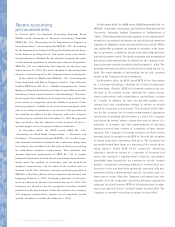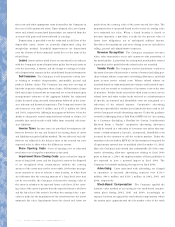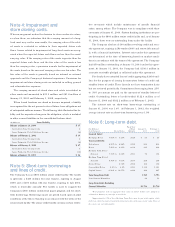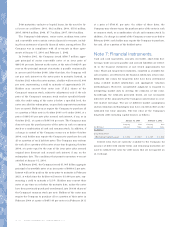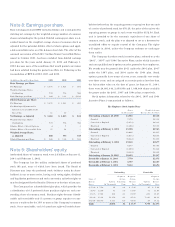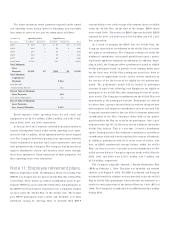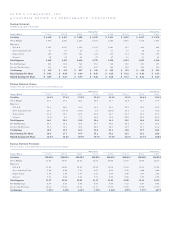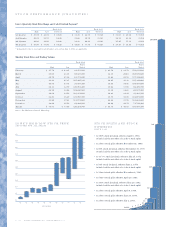Lowe's 2002 Annual Report Download - page 33
Download and view the complete annual report
Please find page 33 of the 2002 Lowe's annual report below. You can navigate through the pages in the report by either clicking on the pages listed below, or by using the keyword search tool below to find specific information within the annual report.
on the date of grant, other than for restricted stock grants. Had
compensation expense for stock options granted in 2002, 2001
and 2000 been determined using the fair value method, the
Company’s net earnings and earnings per share amounts would
approximate the following pro forma amounts:
(In Millions, except per share data) 2002 2001 2000
Net Income as Reported $ 1,471 $ 1,023 $ 810
Deduct: Total stock-based employee
compensation expense determined under
the fair value based method for all awards
net of related tax effects (85) (55) (37)
Pro forma net income $ 1,386 $ 968 $ 773
Earnings per share:
Basic – as reported $ 1.89 $ 1.33 $ 1.06
Basic – pro forma $ 1.78 $ 1.25 $ 1.01
Diluted – as reported $ 1.85 $ 1.30 $ 1.05
Diluted – pro forma $ 1.73 $ 1.22 $ 1.01
The fair value of each option grant is estimated on the date of
grant using the Black-Scholes option-pricing model with the fol-
lowing assumptions:
2002 2001 2000
Weighted average fair value per option $ 19.22 $ 17.39 $ 11.57
Assumptions used:
Weighted average expected volatility 43.7% 41.1% 37.7%
Weighted average expected dividend yield 0.27% 0.23% 0.41%
Weighted average risk-free interest rate 4.35% 4.58% 5.15%
Weighted average expected life, in years 4.0-7.0 7.0 7.0
The Company intends to begin recognizing compensation
expense relating to stock options granted in accordance with the
fair value method in Statement of Financial Accounting Standards
(SFAS) No. 123, “Accounting for Stock-Based Compensation” as
amended by SFAS No. 148, “Accounting for Stock-Based
Compensation
—
Transition and Disclosure” for the fiscal year
beginning February 1, 2003. Please see the section regarding
Recent Accounting Pronouncements for additional information.
Shipping and Handling Costs The Company includes ship-
ping and handling costs relating to the shipment of products to
customers by third parties in cost of sales. Shipping and handling
costs, which include salaries and vehicle operations expenses relat-
ing to the delivery of products to customers by the Company, are
classified as Selling, General and Administrative (SG& A) and
depreciation expenses. Shipping and handling costs included in
SG&A and depreciation were $208.1 million, $177.5 million and
$161.1 million during 2002, 2001 and 2000, respectively.
Recent Accounting Pronouncements In October 2001,
the Financial Accounting Standards Board (FASB) issued SFAS
No. 144, “Accounting for the Impairment or Disposal of Long-
Lived Assets,” which supersedes SFAS No. 121, “Accounting for
the Impairment or Disposal of Long-Lived Assets and for Long-
Lived Assets to be Disposed of,” but retains many of its funda-
mental provisions. Additionally, this statement expands the scope
of discontinued operations to include more disposal transactions.
SFAS No. 144 was adopted by the Company for the fiscal year
ended January 31, 2003. The initial adoption of this standard did
not have a material impact on the Company’s financial statements.
In June 2002, the FASB issued SFAS No. 146, “Accounting for
Costs Associated with Exit or Disposal Activities.” This statement
nullifies EITF Issue No. 94-3, “Liability Recognition for Certain
Employee Termination Benefits and Other Costs to Exit an Activity
(Including Certain Costs Incurred in a Restructuring).” This state-
ment requires that a liability for costs associated with an exit or
disposal activity be recognized when the liability is incurred.
Under previous guidance, a liability for an exit cost was recognized
at the date of an entity’s commitment to an exit plan. The provi-
sions of this standard are effective for the Company with exit or
disposal activities that are initiated after December 31, 2002.
Management does not believe that the adoption of this standard
will have a material impact on the Company’s financial statements.
In December 2002, the FASB issued SFAS No. 148,
“Accounting for Stock-Based Compensation
—
Transition and
Disclosure.” This statement amends SFAS No. 123 in order to pro-
vide alternative methods of transition for a voluntary change from
the intrinsic value method to the fair value method of accounting
for stock-based employee compensation. This statement also
amends disclosure requirements of SFAS No. 123 to require
prominent disclosures in both annual and interim financial state-
ments about the method of accounting used for stock-based
employee compensation and the effect of the method used on
reported results. The alternative transition methods permitted in
SFAS No. 148 will be effective for the Company with the fiscal year
beginning February 1, 2003. Disclosure provisions of this state-
ment are effective for the fiscal year ended January 31, 2003. The
Company has elected to use the prospective transition method
permitted under this standard. Under this method, the Company
will recognize compensation expense for all employee awards
granted, modified, or settled after February 1, 2003.
In November 2002, the FASB issued FASB Interpretation No. 45
(FIN45), “Guarantor’s Accounting and Disclosure Requirements for
Guarantees, Including Indirect Guarantees of Indebtedness of
Others.” This interpretation provides guidance on the disclosures to
be made by a guarantor in its interim and annual financial statements
regarding its obligations under guarantees that it has issued. FIN45





